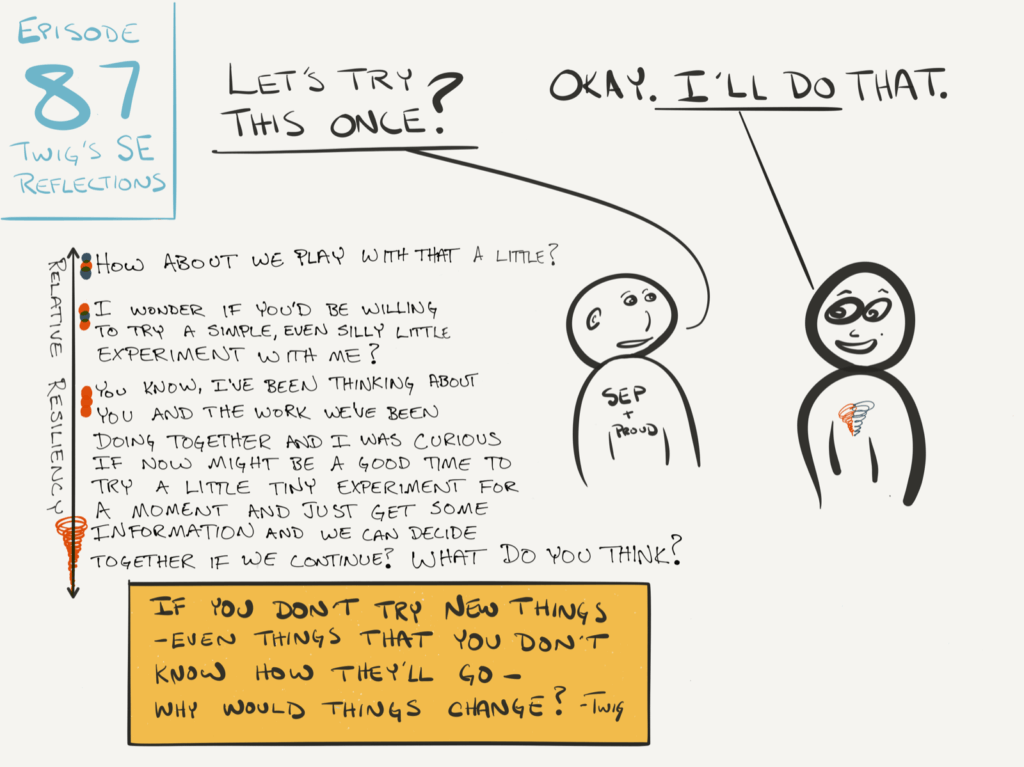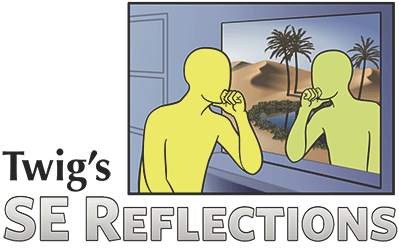
Play Episode 87 Here
Podcast: Play in new window | Download
Subscribe: RSS
Dynamic sessions that move toward productive change rather than maintain the status quo regularly introduce new things.
These include: experiments (also known as excercises), Practitioner behavioral changes (like increasing or decreasing pace of reflections) and trying on of different channels of attention for the client (such as turning toward sensation or image).
In this episode I encourage SE Practitioners to try new things out “once” so that they can read the feedback of how it went and adjust their next interventions accordingly. Simple like that.
Mentions:
I reference a few older SE Reflections episodes this time around, including:
- e.38 – It’s a Try It Out Kind of Thing (in which I encourage your to, well, try things out)
- e.01 – The Importance of Spontaneity (a critical metric for successful movement in sessions)
- e.43 The Formula (how to attend to the storyline without getting caught in the negative parts of it)
- e.77 – Will this Be an “I Can” or “I Can’t” Moment (not mentioned but it could have been.)
Some Added Thoughts:
Sessions are dynamic, not rote experiences.
The new SE client doesn’t necessarily have a complete understanding of the SE session process, nor are they likely to be familiar with the kinds of experiences they’ll encounter in your presence. There’s going to be a lot of new things coming their way.
That’s part of the point of doing therapy in general: To find new ways of being rather than just repeating old ones. Thus Practitioners are going to offer a steady stream of “new” ideas, observations, requests and so on.
Some of these will be transparent to the client, some of them will be more behind the scenes.
On the transparent side will be clear request to try something out, such as “I wonder if you’d be willing to try a little experiment with me here?”.
These are generally best offered invitationally, as something approaching “an experiment”, with attention given to the curiosity of what is found during and after trying this new thing.
It’s probably also best if they’re done with a “beginning, middle and end” with a check-in/evaluation time afterwards to see how it went (also known as “a round”).
Also, it’s easier to manage the expectations from these experiments if you diminish or remove the sense of profundity before the fact. This can be super necessary if, in then end, the experiment doesn’t go anywhere.
What is discovered then helps inform both the client and practitioner of what can be expected next.
Was it easy? Simple? Difficult? Scary? Successful? Productive? Annoying?
Did “tyring that thing” increase intrest, engagement and participation or did it thwart it?
This feedback – from both Client self-report and Practitioner observation – is critical for determining if the request should be titrated up or down, simplified, repeated at the same level or, as is the case sometimes, abandoned altogether or shelved for later.
Then there’s the less transparent side of things. These include behaviors, questions and requests from the Practitioner that are simply layered into the session behind the scenes. We might try to mirror a client’s behavior, comment on positive elements of experience or even ask for internal sensation reflections as in our classic line “Can you tell me what you notice now?”
If the introduction of any of those slows or stalls the session rather than move it forward with more spontaneously, we’re best off reading that feedback and adjusting how we do things next time to garner more ease and acceptance of the new thing.
For example, when a client has a difficult time answering the “What do you feel now?” question, it may be necessary to:
- Clarify the question next time (don’t assume they know what you’re asking for)
- Make it smaller (titrate it down)
- Ask a more oblique question (“If someone else had a response to that kind of thing, what might they be feeling right now?”)
- Offer an external reflection (“I notice as you say that my hackels go up, I don’t know what happens for you, but I can feel my back just get all up in arms!”)
- Or even abandon the request for an internal reflection from the client until other things fall into place where it becomes easier for them to answer with something productive rather than continuing to ask the same “stupid question” over and over getting the same non-productive response.
In that way there’s a relatively easy pattern to follow:
The practitioner notices something they’d like to try or call attention to, such as:
- Have less eye gaze
- Relax more into their chair
- Ask more questions, ask fewer questions
- Ask for felt sense reflections
- And so on…
The Practitioner looks for the moment to “try that once” and watches for the feedback from the client. Did things become:
- More spontaneous or less?
- Move things forward or sideways?
- Confuse or clarify things?
- Engage more interest or less?
- Fill in your own metric here…
From there the Practitioner can choose:
- Do I want to do that again?
- Can I say with that with more clarity next time?
- Offer more distance in the question next time?
- Titrated it up or down so the request is scaled more appropriately?
- Put that idea aside for another time?
This “trying it once” and paying attention to how it went can happen over and over in a session, particularly as new clients are becoming familiar with the SE session process and the Practitioner and Client are getting to know each other.
By trying things out, paying attention to the feedback and responding accordingly you can adjust your interventions for less stall, frustration or repetition and toward more success, spontaneity and momentum.
A Few Words of Caution
You can easily try things out that shouldn’t be tried. It’s easy to get ambitious or demand that you “do SE” and cause sincere disruption to the process or unduly annoy or stress your client.
Therefore it’s important to work from the perspective that when trying new things, even just once, some basis for working together should already be established before trying new terrain.
Issues of having a mutual contract (or developing one), ability to stabilize things if they go sideways and the williness to absorb mistakes and make repairs should all be present.
With those in place…sure, you’ve got an idea of something to explore: Why Not Try It Once!

